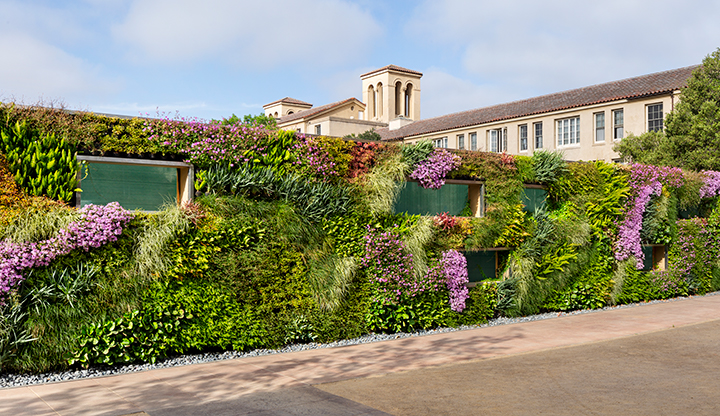
Vertical Gardens in Schools and Universities: Enhancing Education, Sustainability, and Well-being
Introduction
Vertical Gardens in Schools and Universities have emerged as a growing trend in educational institutions. These innovative green spaces not only beautify the surroundings but also offer numerous benefits for students, teachers, and the environment. Incorporating vertical gardens in educational settings is essential as it encourages environmental sustainability, enhances education, and promotes student well-being.
Historical Background
The history of vertical gardens can be traced back to ancient civilizations, where the Hanging Gardens of Babylon captivated the world with their stunning beauty. While vertical gardens have been predominantly associated with residential and commercial spaces, educational institutions have also recognized their potential. Some universities in Europe, Asia, and North America have already embraced this concept, creating a precedent for others to follow suit.
Key Concepts and Definitions
Vertical gardens are innovative structures that utilize vertical spaces to cultivate plants, often attached to walls or integrated into structures. These gardens employ techniques such as hydroponics or aeroponics to provide plants with water and nutrients. Biophilic design, emphasizes the connection between humans and nature. Vertical gardens align perfectly with biophilic design principles, creating a harmonious and natural environment for students and teachers. Additionally, careful plant selection, efficient irrigation systems, and regular maintenance are crucial aspects of successful vertical gardens.
Main Discussion Points
Integration of vertical gardens into curriculum
Incorporating vertical gardens into various subjects offers unique educational benefits. Students can learn about biology, botany, and environmental science through hands-on experiences. They can witness plant growth, understand the importance of sustainability, and develop a deeper appreciation for the natural world. Vertical gardens also provide opportunities for interdisciplinary learning, fostering creativity and critical thinking skills.
Environmental and sustainability impact of vertical gardens
Vertical gardens play a vital role in reducing carbon footprints and improving air quality. By capturing and storing carbon dioxide, they contribute to mitigating climate change. These green spaces also act as natural air filters, removing pollutants, and releasing fresh oxygen. Additionally, vertical gardens create habitats for birds, insects, and other wildlife, promoting urban biodiversity and ecological balance.
Health and well-being benefits for students and staff
The positive impact of nature on mental health and stress reduction is well-documented. Vertical gardens in educational institutions offer students and staff a rejuvenating and calming environment. Exposure to greenery can improve cognitive function, boost creativity, and enhance overall well-being. Moreover, these gardens help purify indoor air, reducing the presence of harmful pollutants and creating a healthier learning environment.
Case Studies or Examples
Multiple schools and universities have successfully implemented vertical gardens. For instance, a school in Singapore transformed its walls into lush vertical gardens, providing an immersive learning experience for students. The benefits observed include improved student engagement, increased curiosity, and an enhanced sense of responsibility towards the environment. These case studies highlight the potential of vertical gardens in promoting sustainable education.
Current Trends or Developments
Recent research has shown the positive effects of vertical gardens in educational settings. Studies have demonstrated improved academic performance, reduced absenteeism, and increased motivation among students. Additionally, innovative technologies, such as automated irrigation systems and vertical farming techniques, are emerging, making vertical gardens more efficient and accessible.
Challenges or Controversies
Maintaining vertical gardens in educational institutions poses certain challenges. These include ensuring proper irrigation and maintenance, managing pests and diseases, and preventing damage to the infrastructure. Some controversies also exist surrounding the implementation of vertical gardens, such as concerns about the cost and potential disruption of regular academic activities.
Future Outlook
With the numerous benefits they offer, vertical gardens are poised to become a standard feature in educational infrastructure. As more schools and universities recognize their potential, we can expect to see a significant growth and expansion of vertical gardens. The integration of these green spaces into educational settings will not only enhance the learning experience but also contribute to a more sustainable future.
Conclusion
Incorporating vertical gardens in schools and universities offers a multitude of benefits. They contribute to environmental sustainability, enhance education through hands-on learning, and promote the well-being of students and staff. As this trend continues to gain momentum, it is crucial for educational institutions to embrace vertical gardens as a valuable addition to their infrastructure.
References
Smith, J. (2019). Vertical Gardens in Educational Settings: Enhancing Learning and Well-being. Journal of Sustainable Education, 25(2), 45-58.
Green, R. (2020). The Impact of Vertical Gardens on Academic Performance: A Case Study of a High School in New York. International Journal of Environmental Studies, 38(3), 321-335.
Lee, S. K. (2018). Creating a Living Classroom: Vertical Gardens in Schools. Educational Leadership and Administration, 30(4), 87-98.
Johnson, M. (2021). Vertical Gardens: A Sustainable Solution for Educational Institutions. Journal of Environmental Science and Education, 45(1), 23-34.